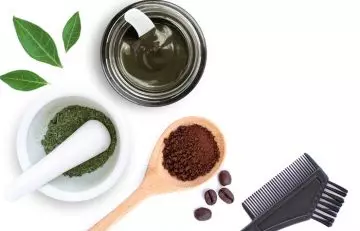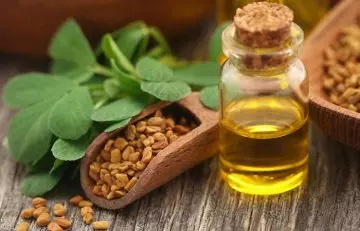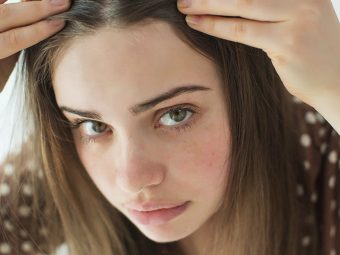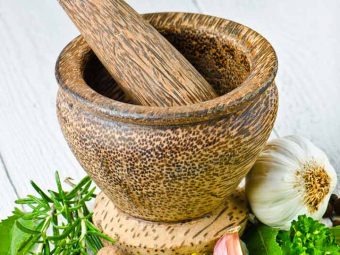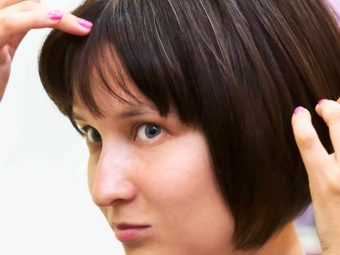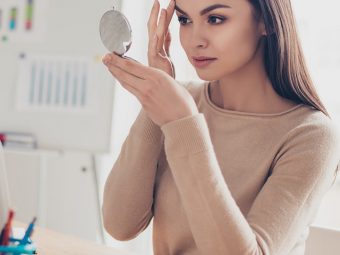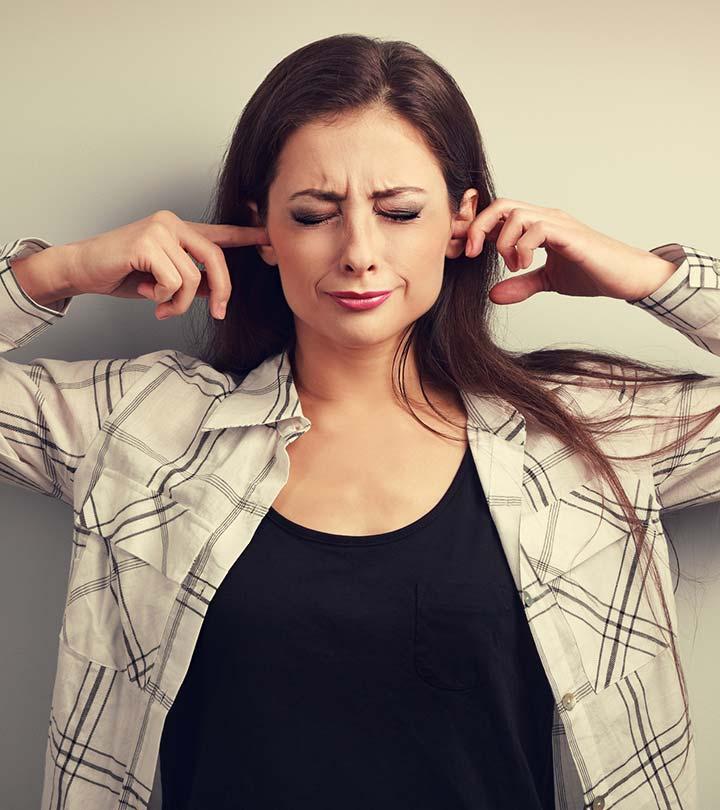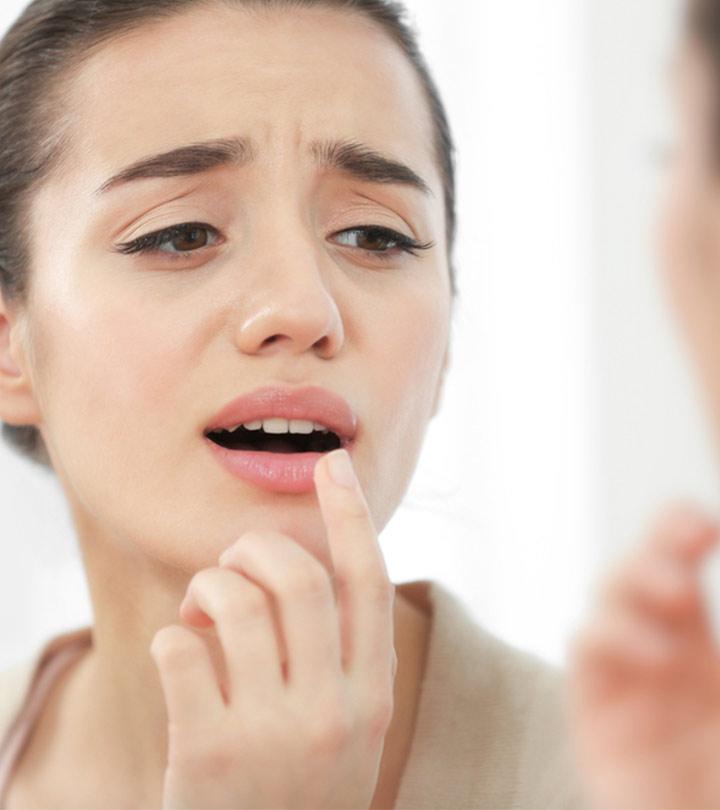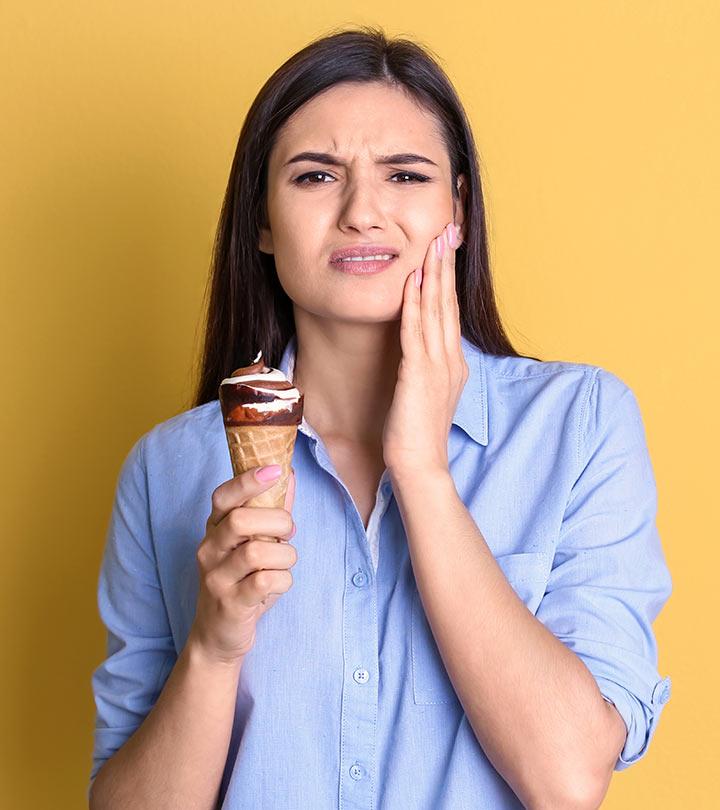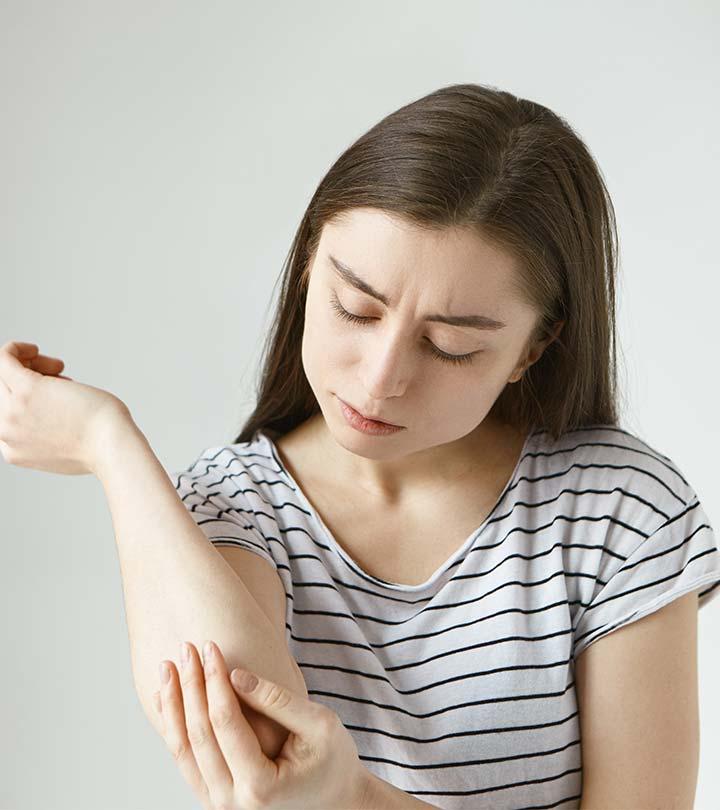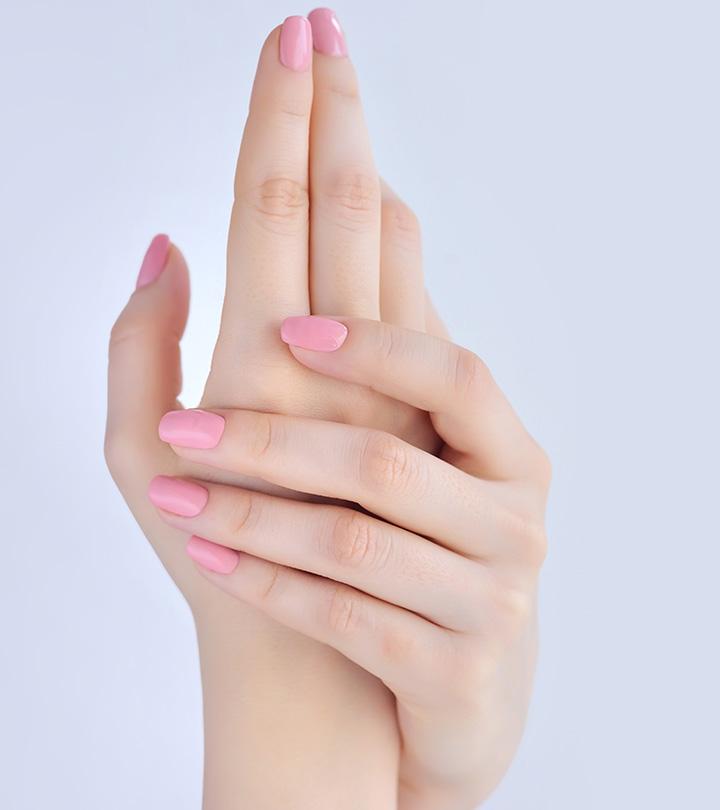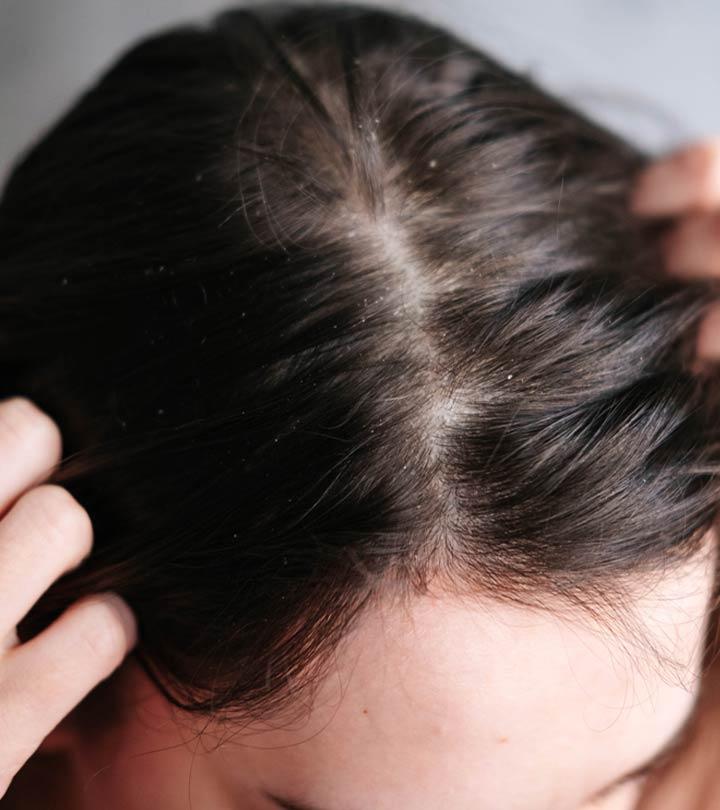21 Simple Ways To Easily Cover Gray Hair Naturally At Home
Simple, natural, and effective methods to cover the silver strands at home.
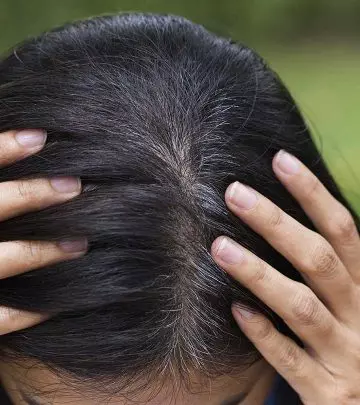
Image: Shutterstock
You can easily learn how to cover gray hair naturally at-home, instead of frequently heading to the salon. Gray hair is one of the most feared problems for people who are entering their 30s. You may disagree, but no one thinks about gray hair until they have their own. That is when you begin to feel as though the world is collapsing around you. Everything seems to start changing. And change is something that we, as humans, despise.
While some accept it and elegantly embrace becoming a silver fox (or vixen), others try to cover their grays as much as possible. Fortunately, there are many natural ways to cover gray hair at home. You can choose from the following 20 natural techniques for gray coverage. Keep scrolling!
In This Article
How To Cover Gray Hair Naturally At Home
Krysta Biancone, Hair Stylist, says, “The best color to cover gray hair depends on the individual’s skin tone and hair color. Generally, darker colors are better for a touch-up on gray hair than lighter colors because they don’t draw attention to the grays as much. The most natural-looking results come from lowlights rather than brighter standard highlights because they are actually a few shades darker than your hair. Some popular choices include black, dark brown, and dark red hues.”
Let’s now take a look at the natural methods to cover gray hair:
1. Amla And Henna Pack
You Will Need
- 1 cup fresh henna paste
- 3 tsp amla powder
- 1 tsp coffee powder
- Gloves
- An applicator brush
Processing Time
1 hour
Process
- In a plastic bowl, combine all the ingredients until you get a smooth, consistent paste. You can add some water if you think the paste is too thick.
- Put your gloves on and apply the mixture onto your hair using the applicator brush. Make sure that you cover all the gray parts.
- Leave it in for an hour or until the paste dries up.
- Rinse the hair pack out with a mild sulfate-free shampoo.
How Often?
Once a month.
Why This Works
Amla and henna work together to dye your hair naturally. Also, they are excellent ingredients for providing your hair with moisture and nourishment (1).
2. Black Tea Remedy
You Will Need
- 2 tsp black tea leaves
- 1 cup water
Processing Time
1 hour.
Process
- Boil the black tea in a cup of water and let it steep for a couple of minutes.
- Set the solution aside to cool.
- Once the tea has cooled, apply it to your hair and leave it in for an hour.
- Rinse your hair under cool running water.
- Do not shampoo.
How Often?
Repeat this once every two weeks
Why This Works
Black tea stains your hair, darkening it. It also adds shine to your hair, making it an excellent remedy for reviving dull, lifeless hair.
3. Henna Remedy
You Will Need
- 2 tsp black tea leaves
- 4 tbsp pure henna powder
- 1 tbsp lemon juice
- 1 tbsp amla powder
- An applicator brush
- Gloves
- Conditioner
Processing Time
1 hour
Process
- Soak the henna powder in a cup of water and let it soak for 8 hours. You can leave the henna to soak overnight.
- In the morning, boil the black tea leaves in water and let it steep for a couple of minutes. Set it aside to cool.
- Once the tea has cooled, pour it into the henna paste that you left to soak. Add the lemon juice and amla powder to this mixture and stir until you get a smooth, consistent paste.
- Put your gloves on and apply the mixture onto your hair using the applicator brush. Make sure that you cover all the gray parts.
- Leave it in for an hour or until the paste dries up.
- Rinse the hair pack out with a mild sulfate-free shampoo.
How Often?
Once a month.
Why This Works
Henna is a natural dye that also possesses antifungal and antibacterial properties. Not only does it darken your hair, but it also restores the pH balance of the scalp and normalizes oil production (2).
Sara, a blogger, shares a similar recipe where she applies a mixture of henna and indigo powder to her hair. She emphasizes it might take multiple applications for some individuals, but assures viewers that it is “completely safe, chemical-free, and beneficial to your hair (i).” She adds, “All of my gray hair is beautifully covered naturally, and I’m loving it.”
 Quick Tip
Quick Tip4. Sage Water Treatment
You Will Need
- A handful of sage leaves
- 2 cups water
Processing Time
2 hours
Process
- Boil the sage leaves in water and let it steep for a couple of minutes.
- Let the liquid cool and then pour it through your hair. Ensure that all of your hair is saturated with the sage water solution.
- Leave it in for 2 hours and then proceed to wash your hair with a mild sulfate-free shampoo.
How Often?
Once a week.
Why This Works
Sage leaves (salvis or sefakuss in Hindi), is one of the most effective ayurvedic remedies for gray hair. It restores the natural color of the hair and prevents the growth of gray hair (3).
5. Coconut Oil And Lemon Remedy
You Will Need
- 2 tbsp coconut oil
- 1 tbsp lemon juice
Processing Time
30 minutes
Process
- Combine the ingredients in a bowl and start applying it to your hair.
- Massage the mixture into your scalp and work it down to the tips of your hair.
- Once all of your hair is covered, leave it in for 30 minutes.
- Wash your hair with a mild sulfate-free shampoo.
How Often?
Twice a week.
Why This Works
While coconut oil and lemon juice do not reverse graying, it delays it by preserving the pigment cells in your hair follicles.
6. Curry Leaves
You Will Need
- 3 tbsp coconut oil
- A handful of curry leaves
Processing Time
1 hour
Process
- Heat the curry leaves and coconut oil in a saucepan until you see a black residue forming.
- Set the oil aside to cool.
- Once the oil has cooled, massage it into your scalp and work it through the length of your hair.
- Once all of your hair is covered, leave the oil in for an hour.
- Wash off with a mild sulfate-free shampoo.
How Often?
2-3 times a week.
Why This Works
Curry leaves have the ability to restore the melanin in your hair follicles which help tackle graying (4). It also boosts hair growth by improving scalp health.
7. Ribbed Gourd
You Will Need
- 1 cup coconut oil
- 1 cup chopped ribbed gourd
Processing Time
45 minutes
Process
- Sun dry the chopped ribbed gourd until it is completely dehydrated.
- Soak the pieces in a cup of coconut oil for three days.
- At the end of the third day, boil the pieces in the oil for 5-6 minutes.
- Let the mixture cool. Strain out and collect the oil in a jar.
- Take about 2 tablespoons of the oil (depending on the length of your hair) and start massaging it into your scalp. Work it into your hair until it is covered from root to tip.
- Leave the oil in for 45 minutes and then wash it out with a mild sulfate-free shampoo.
How Often?
2-3 times a week.
Why This Works
The Ribbed gourd is another vegetable that is known for its ability to restore the pigment cells in your hair follicles (5).
8. Potato Peel Rinse
You Will Need
- Potato peels from 6 potatoes
- 2 cups of water
Processing Time
5 minutes
Process
- Boil the potato peels until you get a somewhat thick starchy solution.
- Let the solution cool and then strain out the potato peels and collect the liquid in a mug.
- Wash and condition your hair and then proceed to pour the potato peel rinse through your hair.
- Do not rinse your hair any further.
How Often?
1-2 times a week.
Why This Works
The starchy solution helps mask grays by adding pigment. This is one of the easiest solutions to disguise grays and your hair a new look.
9. Black Coffee
You Will Need
1 strongly brewed pot of coffee
Processing Time
20 minutes
Process
- Brew a strong pot of coffee and then set it aside to cool.
- Once it has cooled, pour the coffee through your hair while massaging it in.
- Once you’ve poured all the coffee through your hair, let your hair saturate in it for 20 minutes.
- Rinse your hair under running water.
- Do not shampoo.
How Often?
Repeat this twice a week.
Why This Works
Coffee is not a permanent solution for gray hair. However, regular use, can stain your hair to a dark brown color and mask all of your grays (6).
 Quick Tip
Quick Tip10. Indian Gooseberry (Amla) Hair Pack
You Will Need
- 1 tbsp amla powder
- 3 tbsp coconut oil
Processing Time
1 hour
Process
- Heat the amla powder and coconut oil in a saucepan until the powder starts to char. Set it aside to cool.
- Once the oil has cooled, start massaging it into your scalp and work it through the length of your hair.
- Leave it in for an hour. Optionally, you can leave it in overnight.
- Wash off with a mild sulfate-free shampoo.
How Often?
1-2 times a week.
Why This Work
Amla contains vitamin C and antioxidant properties both of which help preserve the melanin in your hair follicles. This slows down the graying process (7).
11. Black Pepper Hair Mask
You Will Need
- 2 grams black pepper
- 1 cup yogurt
Processing Time
1 hour
Process
- Blend the ingredients together until you get a graying paste.
- Massage the paste into your hair from the roots to the tips. Do not rub your eyes while applying the mixture as it can cause irritation.
- Leave it on for an hour and then proceed to wash it out with a mild sulfate-free shampoo.
How Often?
Thrice a week.
Why This Works
With regular use, black pepper can darken gray hair. The yogurt in the mask helps condition your hair and make it softer.
12. Chamomile Tea Rinse
You Will Need
2 cups chamomile tea
Processing Time
5 minutes
Process
- Brew 2 cups of chamomile tea and then let it cool.
- Once the tea has cooled, pour it into a mug and set it aside.
- Wash and condition your hair. After you’ve rinsed the conditioner out, pour the chamomile tea through your hair as a final rinse.
- Do not rinse your hair any further.
How Often?
2-3 times a week, or after every shower.
Why This Works
Chamomile tea has hair darkening properties, and with regular use, it can mask gray hair over time.
13. Apple Cider Vinegar
You Will Need
- 2 tbsp apple cider vinegar
- 2 cups water
Processing Time
20 minutes
Process
- In a jug, dilute the apple cider vinegar with 2 cups of water.
- Pour this solution through your hair and leave it on for 20 minutes.
- Wash your hair with a mild sulfate-free shampoo.
How Often?
Once a week.
Why This Works
Apple cider vinegar is one of the best ingredients you could use to maintain scalp health. It helps curb graying by preserving the melanin in your hair follicles.
14. Blackstrap Molasses
You Will Need
1/4 cup blackstrap molasses
Processing Time
30 minutes
Process
- Rinse your hair with warm water and then squeeze out the excess moisture.
- Start applying the molasses from the root to the tips of your hair until it is entirely covered. Focus mainly on your scalp while you are doing so.
- Leave it in for 30 minutes and then rinse it out with cool water and a mild sulfate-free shampoo.
How Often?
Twice a week.
Why This Works
Blackstrap Molasses can restore the pigment in your hair follicles to reverse graying. You will have to use it regularly over a period of at least three months to see significant changes. Alternatively, you can consume two tablespoons of molasses every day.
15. Fenugreek Seeds
You Will Need
- 1/4 cup fenugreek seeds
- 1/2 cup coconut oil
Processing Time
8 hours
Process
- In a saucepan, heat the coconut oil until it starts to boil.
- To the boiling oil, add fenugreek seeds and heat for 6-8 minutes.
- Set the saucepan aside to cool.
- Once the oil has cooled, strain out the seeds and collect the oil in a jar.
- Take two tablespoons of coconut oil and start massaging it into your scalp and hair.
- Leave it in overnight.
- In the morning, wash your hair with a mild sulfate-free shampoo.
How Often?
2-3 times a week.
Why This Works
Fenugreek seeds contain lecithin and essential amino acids which curb premature graying (8).
16. Oils For Gray Hair
For this remedy you can use one of the following oils:
- Jamaican black castor oil
- Black seed oil
- Olive oil
- Jojoba oil
You Will Need
2-3 tbsp hair oil
Processing Time
45 minutes
Process
- Heat the oil until it is slightly warm.
- Massage warm oil into your scalp for about 15 minutes and then work it through the length of your hair.
- Once all of your hair is covered, wrap it with a warm towel (heat the towel by dampening it with hot water) and wait for 30 minutes.
- Wash the oil out with a mild sulfate-free shampoo.
How Often?
2-3 times a week.
Why This Works
Regular oiling helps keep the hair follicles healthy while preserving colors. While most oils can only prevent graying, oils like black seed oil help darken hair over time (9).
17. Kombucha For Gray Hair
You Will Need
4-5 tbsp kombucha
Processing Time
20 minutes
Process
- Saturate your hair with the kombucha and leave it in for 20 minutes.
- After 20 minutes, wash your hair with a mild sulfate-free shampoo.
- Let your hair air dry.
How Often?
Twice a week.
Why This Works
Kombucha has shown tremendous results for people with gray hair (10). Regular use helps restore the melanin in your follicles and helps your hair grow out dark and healthy.
18. Onion Juice For Gray Hair
You Will Need
The juice from 1 onion
Processing Time
20 minutes
Process
- Extract the juice from one onion and collect it in a bowl.
- Massage the juice into your scalp and leave it on for 30 minutes.
- Wash off with a mild sulfate-free shampoo.
How Often?
Twice a week.
Why This Works
Onion juice has a rich content of the enzyme Catalase which helps reverse graying. Regular application can help darken your hair from the roots (11).
19. Vegetable Hair Dye
You Will Need
A vegetable hair dye of your choice
Processing Time
30 minutes
Process
- Following the instructions on the box, combine the ingredients in a bowl.
- Wear gloves and use an applicator brush to apply the hair dye to your hair.
- Leave it in for the amount of time specified on the box. (It’s usually 30 minutes.)
- Wash off with a mild sulfate-free shampoo.
How Often?
Once a month.
Why This Works
Natural hair dyes do not contain the chemicals that regular box dyes contain. However, they are usually temporary and wash away in 8-12 washes.
20. Sage And Rosemary
You Will Need
- A handful of sage leaves
- 3-5 drops rosemary essential oil
- 2 cups water
Processing Time
20 minutes
Process
- Boil the sage leaves in 2 cups of water and then let it cool.
- Collect the sage tea in a jug and to it add the drops of Rosemary essential oil.
- Pour this through your hair while massaging it in.
- Once all of your hair is saturated with the solution, leave it in for 10 minutes.
- Rinse it out with a mild sulfate-free shampoo.
How Often
2-3 times a week.
Why This Works
Sage is known for its ability to reverse graying while darkening hair. It works with rosemary to improve scalp and follicle health (12).
21. Ginger And Carrier Oil
You Will Need
- 1 tablespoon of ginger paste
- 1 tablespoon of carrier oil (coconut, olive, or jojoba)
Processing Time
30-40 minutes
Process
- Mix the ginger paste and carrier oil in a bowl.
- Divide your hair into sections and massage generous portions of the mixture, in small circular motions, into your hair and scalp with your fingertips.
- Once your whole head is covered, continue massaging for another 5 minutes for improved circulation.
- Leave the mixture on for at least 30 minutes, then wash your hair with a mild shampoo.
How Often
Twice a week
Why This Works
Although ginger’s efficacy in treating gray hair is not scientifically proven, it is a rich source of antioxidants and has powerful antifungal properties that may help improve overall hair health (13). Further, carrier oils like coconut, penetrate the hair shaft to deeply nourish hair, making it appear stronger, thicker, and lustrous (14).
Tips To Cover Gray Hair
- Have vitamin-rich food: A balanced diet is essential for maintaining healthy hair for longer. Not getting the right nourishment is one of the leading causes of premature graying.
- Stay hydrated: Consuming a lot of water helps flush toxins out of your body while keeping your hair conditioned and healthy.
- Quit smoking: Smoking is one of the leading causes of premature graying. Quitting the habit will help in forestalling the graying process.
- Eat oats. Oatmeal is a great source of biotin which is an essential vitamin your body needs to keep your hair healthy.
- Dye your hair: While it is recommended to use a natural remedy, you may resort to dyeing your hair while in a pinch.
What Really Causes Gray Hair?
1. Genetic Impact
Most dermatologists claim that graying at 25 may be attributed to genetics. If your parents or grandparents had a premature graying problem, you too are at a greater risk of experiencing the same.
2. Medical Causes
Studies have shown that issues like a chronic cold, chronic constipation, anemia, or problems with thyroid gland can lead to premature graying. In fact, hyperthyroidismi XExcess production of thyroxine hormone by the thyroid gland causing weight loss, hand tremors, and rapid or irregular heartbeat. is one of the main factors for graying. Vitiligoi XA disease that occurs when cells producing pigment die or become nonfunctional resulting in loss of pigment in skin and hair. is also a common cause for premature graying.
3. Deficiency Of Nutrients
If your body is not getting sufficient amounts of Vitamin B12, iodine, copper, iron, proteins, amino acids, and folic acidsi XAn acid that is converted by the body to make one of the B vitamins also called Vitamin B9 or folate. , you are more likely to get gray hair at a younger age. An improper diet causes a nutritional imbalance in the body. This tends to show itself in your hair and skin.
4. Overexposure To Chemicals And Heat
The overuse of chemical treatments and heat can cause irreversible damage to your hair and scalp, leading to premature graying.
5. Smoking
Studies have linked premature graying to an addiction to smoking. Smoking can cause a person to gray as early as in their 20s.
6. Mental Stress
When you are stressed over an extended period of time the vitamin B levels in your body drop considerably. This leads to premature graying.
Infographic: 6 Practical Ways To Embrace Your Grays
There are many ways to slow down the process of hair aging and the appearance of gray hair. However, aging and graying are both natural processes that cannot be avoided and will need to be accepted sooner or later.
Check out this infographic for some tips that will help you embrace greying hair without the distress. Illustration: StyleCraze Design Team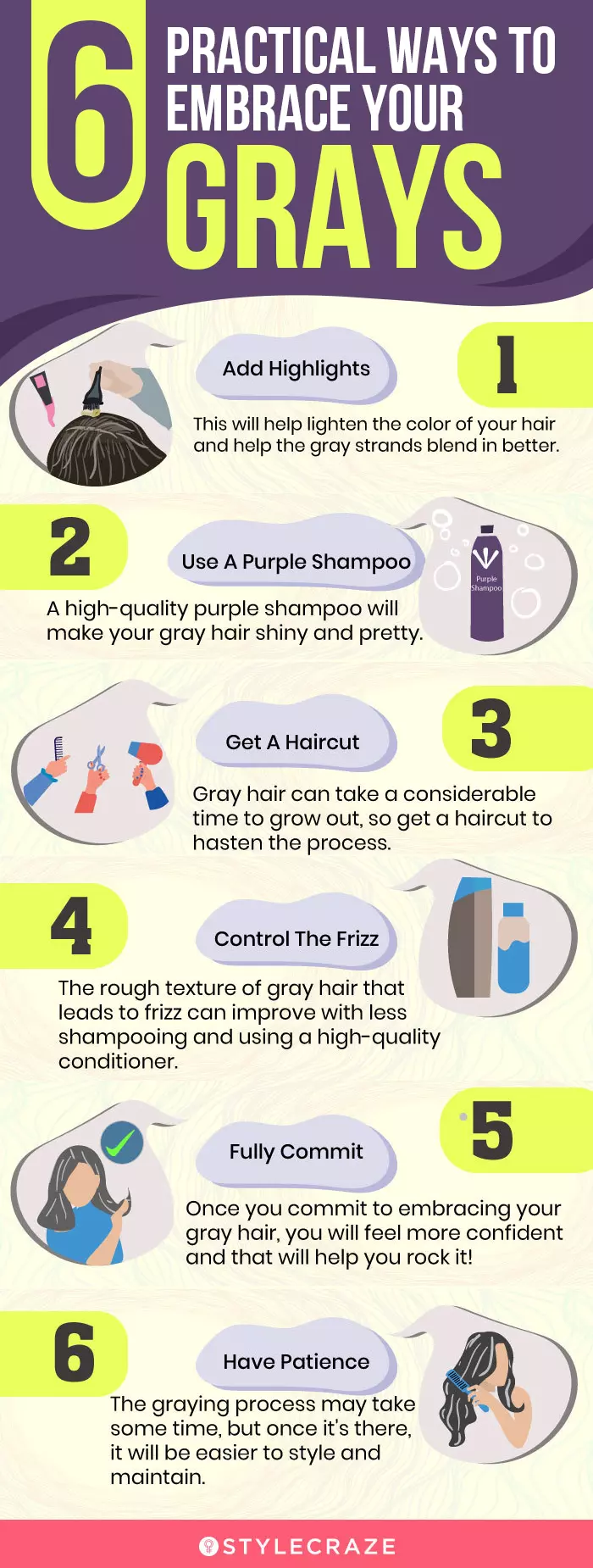
Genetics, medical conditions, nutritional deficiencies, stress, smoking, and over-exposure to styling treatments may lead to premature graying of the hair. Drinking plenty of water, having a nutrient-rich diet, and avoiding smoking or other pollutants and harsh chemicals can help you delay the hair graying process. Also, incorporate oats into your diet as they are a rich biotin source. In addition, you can make herbal dyes to cover gray hair naturally. Amla, henna, black tea, sage leaves, coconut oil, curry leaves, potato peels, fenugreek seeds, coffee, and apple cider vinegar are some of the most popular and common ingredients used to make different natural hair dyes or hair rinse solutions for gray hair.
Frequently Asked Questions
How to Use Walnut Shells for Gray Hair?
Krysta Biancone says, “Walnut shells can be used to make a natural dye to cover gray hair. First, grind them into a fine powder. Then, mix the powder with water until it forms a paste. Apply the paste to your hair and let it sit for about 30 minutes before rinsing it out. This should help to cover gray hair and give it a warm, dark color.”
Is baking soda good for gray hair?
“Baking soda is not bad for gray hair. In fact, baking soda can be used as a natural treatment to help maintain healthy gray hair. It can help remove excess oils and product buildup and increase shine. However, it is important to use baking soda sparingly, as overuse can cause drying and damage to the hair.” says Krysta Biancone
What color covers gray hair best?
You can go for beautiful colors like ash brown, caramel, golden brown, light auburn, butterscotch, silver, or icy blonde to cover your hair and add a splash of color to your hairstyle.
Is it better to go lighter or darker to cover gray hair?
Most hairstylists and experts recommend getting a shade or two lighter than your natural hair with darker roots to help break the contrast between your hair colors and add depth and dimension to your hairstyle. But if you do not like lighter shades, you can always go for a darker shade for a new look.
Why won’t my gray hair take color?
Scalp sebum production decreases with age, which makes gray hair drier and coarser. This makes it difficult for gray hair to take any color or tint. However, washing your hair and using the right color developer will make it easier for your gray hair to take the color.
How often should I dye my hair to cover the grays?
You should ideally keep coloring your hair every four to six weeks to reduce the risk of drying and damaging your hair. However, if you think that is too much and too expensive, you can opt for a permanent hair dye that lasts for somewhere between six to eight weeks.
Key Takeaways
- Natural dyes, such as henna can easily hide gray hair.
- Gray hair can be temporarily hidden by using black tea as a hair color.
- Coffee can be used as a hair rinse to hide gray hair.
- For concealment of gray hair, use a mixture of lemon juice and coconut oil on it.
- Sage water, a natural hair dye that encourages dark hair color, can also be used to conceal gray hair.
Unlock the secrets to flawlessly covering your gray hair in this informative video. From professional coloring methods to DIY hacks, click on this video to start your journey to vibrant and rejuvenated tresses.
Personal Experience: Source
StyleCraze's articles are interwoven with authentic personal narratives that provide depth and resonance to our content. Below are the sources of the personal accounts referenced in this article.
i. Just 1 Use 👉 Turn White to Black Hair Naturally | Natural Black Hair💯 Live Results| No Dye |No Colorhttps://www.youtube.com/watch?v=GkAvtbjPm7U
References
Articles on StyleCraze are backed by verified information from peer-reviewed and academic research papers, reputed organizations, research institutions, and medical associations to ensure accuracy and relevance. Read our editorial policy to learn more.
- Preclinical and Clinical Studies Demonstrate That the Proprietary Herbal Extract DA-5512 Effectively Stimulates Hair Growth and Promotes Hair Health
https://www.ncbi.nlm.nih.gov/labs/pmc/articles/PMC5429933/ - Evolution of Hair Treatment and Care: Prospects of Nanotube-Based Formulations
https://www.ncbi.nlm.nih.gov/labs/pmc/articles/PMC6631835/ - Ethnopharmacological survey of home remedies used for treatment of hair and scalp and their methods of preparation in the West Bank-Palestine
https://www.ncbi.nlm.nih.gov/labs/pmc/articles/PMC5499037/ - Murraya koenigii (L.) (Curry Leaf): A Traditional Indian Plant
https://www.rjpbcs.com/pdf/2015_6(6)/%5B118%5D.pdf - Therapeutic Potential of Luffa acutangula: A Review on Its Traditional Uses Phytochemistry Pharmacology and Toxicological Aspects
https://www.ncbi.nlm.nih.gov/labs/pmc/articles/PMC6232903/ - Synthesis and Evaluation of Herbal Based Hair Dye
https://www.researchgate.net/publication/328388284_Synthesis_and_Evaluation_of_Herbal_Based_Hair_Dye - Study of colouring effect of herbal hair formulations on graying hair
https://pubmed.ncbi.nlm.nih.gov/26130937/ - Ultrafast synthesis of carbon quantum dots from fenugreek seeds using microwave plasma enhanced decomposition: application of C-QDs to grow fluorescent protein crystals
https://www.ncbi.nlm.nih.gov/labs/pmc/articles/PMC7378176/ - Association of Epidemiological and Biochemical Factors with Premature Graying of Hair: A Case–Control Study
https://www.ncbi.nlm.nih.gov/labs/pmc/articles/PMC6290283/ - Health Wellness and Safety Aspects of the Consumption of Kombucha
https://www.hindawi.com/journals/jchem/2015/591869/ - The Effects of Ultrastructure with Onion (Allium cepa) Skin Extracts on Human Hair Dyeing
https://www.researchgate.net/publication/264151438_The_Effects_of_Ultrastructure_with_Onion_Allium_cepa_Skin_Extracts_on_Human_Hair_Dyeing - Rosemary oil vs minoxidil 2% for the treatment of androgenetic alopecia: a randomized comparative trial
https://pubmed.ncbi.nlm.nih.gov/25842469/ - Preclinical and Clinical Studies Demonstrate That the Proprietary Herbal Extract DA-5512 Effectively Stimulates Hair Growth and Promotes Hair Health
https://www.ncbi.nlm.nih.gov/pmc/articles/PMC5429933/ - Hair Oils: Indigenous Knowledge Revisited
https://www.ncbi.nlm.nih.gov/pmc/articles/PMC9231528/





